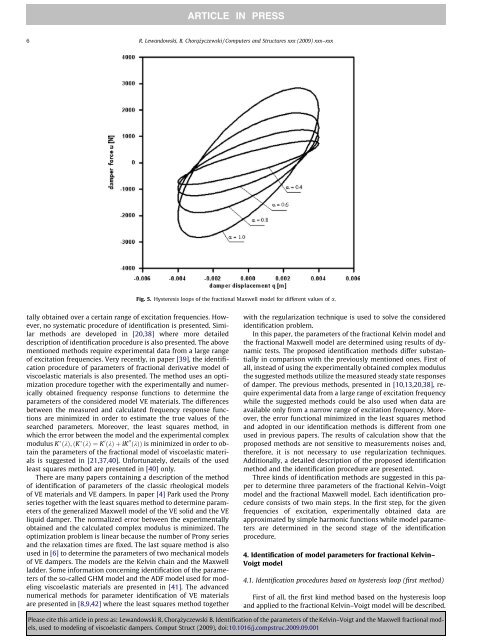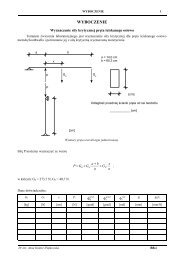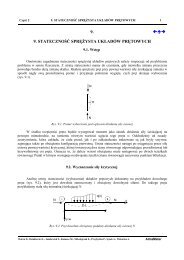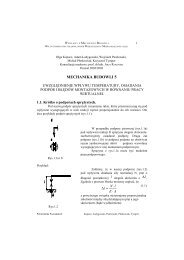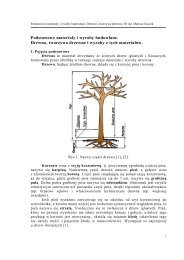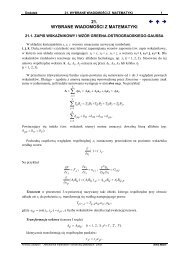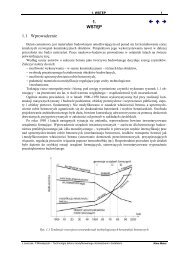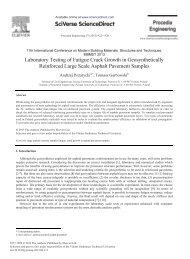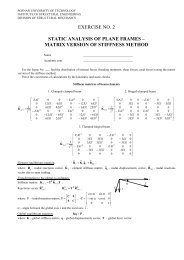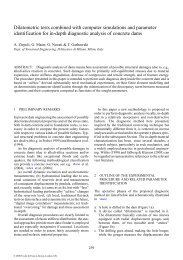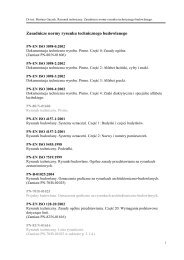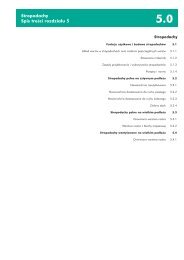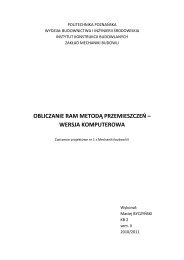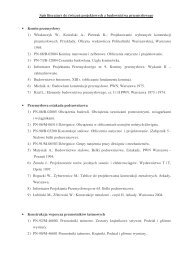Identification of the parameters of the Kelvin–Voigt and the Maxwell ...
Identification of the parameters of the Kelvin–Voigt and the Maxwell ...
Identification of the parameters of the Kelvin–Voigt and the Maxwell ...
You also want an ePaper? Increase the reach of your titles
YUMPU automatically turns print PDFs into web optimized ePapers that Google loves.
ARTICLE IN PRESS<br />
6 R. Lew<strong>and</strong>owski, B. Chorą_zyczewski / Computers <strong>and</strong> Structures xxx (2009) xxx–xxx<br />
Fig. 5. Hysteresis loops <strong>of</strong> <strong>the</strong> fractional <strong>Maxwell</strong> model for different values <strong>of</strong> a.<br />
tally obtained over a certain range <strong>of</strong> excitation frequencies. However,<br />
no systematic procedure <strong>of</strong> identification is presented. Similar<br />
methods are developed in [20,38] where more detailed<br />
description <strong>of</strong> identification procedure is also presented. The above<br />
mentioned methods require experimental data from a large range<br />
<strong>of</strong> excitation frequencies. Very recently, in paper [39], <strong>the</strong> identification<br />
procedure <strong>of</strong> <strong>parameters</strong> <strong>of</strong> fractional derivative model <strong>of</strong><br />
viscoelastic materials is also presented. The method uses an optimization<br />
procedure toge<strong>the</strong>r with <strong>the</strong> experimentally <strong>and</strong> numerically<br />
obtained frequency response functions to determine <strong>the</strong><br />
<strong>parameters</strong> <strong>of</strong> <strong>the</strong> considered model VE materials. The differences<br />
between <strong>the</strong> measured <strong>and</strong> calculated frequency response functions<br />
are minimized in order to estimate <strong>the</strong> true values <strong>of</strong> <strong>the</strong><br />
searched <strong>parameters</strong>. Moreover, <strong>the</strong> least squares method, in<br />
which <strong>the</strong> error between <strong>the</strong> model <strong>and</strong> <strong>the</strong> experimental complex<br />
modulus K ðkÞ; ðK ðkÞ ¼K 0 ðkÞþiK 00 ðkÞÞ is minimized in order to obtain<br />
<strong>the</strong> <strong>parameters</strong> <strong>of</strong> <strong>the</strong> fractional model <strong>of</strong> viscoelastic materials<br />
is suggested in [21,37,40]. Unfortunately, details <strong>of</strong> <strong>the</strong> used<br />
least squares method are presented in [40] only.<br />
There are many papers containing a description <strong>of</strong> <strong>the</strong> method<br />
<strong>of</strong> identification <strong>of</strong> <strong>parameters</strong> <strong>of</strong> <strong>the</strong> classic rheological models<br />
<strong>of</strong> VE materials <strong>and</strong> VE dampers. In paper [4] Park used <strong>the</strong> Prony<br />
series toge<strong>the</strong>r with <strong>the</strong> least squares method to determine <strong>parameters</strong><br />
<strong>of</strong> <strong>the</strong> generalized <strong>Maxwell</strong> model <strong>of</strong> <strong>the</strong> VE solid <strong>and</strong> <strong>the</strong> VE<br />
liquid damper. The normalized error between <strong>the</strong> experimentally<br />
obtained <strong>and</strong> <strong>the</strong> calculated complex modulus is minimized. The<br />
optimization problem is linear because <strong>the</strong> number <strong>of</strong> Prony series<br />
<strong>and</strong> <strong>the</strong> relaxation times are fixed. The last square method is also<br />
used in [6] to determine <strong>the</strong> <strong>parameters</strong> <strong>of</strong> two mechanical models<br />
<strong>of</strong> VE dampers. The models are <strong>the</strong> Kelvin chain <strong>and</strong> <strong>the</strong> <strong>Maxwell</strong><br />
ladder. Some information concerning identification <strong>of</strong> <strong>the</strong> <strong>parameters</strong><br />
<strong>of</strong> <strong>the</strong> so-called GHM model <strong>and</strong> <strong>the</strong> ADF model used for modeling<br />
viscoelastic materials are presented in [41]. The advanced<br />
numerical methods for parameter identification <strong>of</strong> VE materials<br />
are presented in [8,9,42] where <strong>the</strong> least squares method toge<strong>the</strong>r<br />
with <strong>the</strong> regularization technique is used to solve <strong>the</strong> considered<br />
identification problem.<br />
In this paper, <strong>the</strong> <strong>parameters</strong> <strong>of</strong> <strong>the</strong> fractional Kelvin model <strong>and</strong><br />
<strong>the</strong> fractional <strong>Maxwell</strong> model are determined using results <strong>of</strong> dynamic<br />
tests. The proposed identification methods differ substantially<br />
in comparison with <strong>the</strong> previously mentioned ones. First <strong>of</strong><br />
all, instead <strong>of</strong> using <strong>the</strong> experimentally obtained complex modulus<br />
<strong>the</strong> suggested methods utilize <strong>the</strong> measured steady state responses<br />
<strong>of</strong> damper. The previous methods, presented in [10,13,20,38], require<br />
experimental data from a large range <strong>of</strong> excitation frequency<br />
while <strong>the</strong> suggested methods could be also used when data are<br />
available only from a narrow range <strong>of</strong> excitation frequency. Moreover,<br />
<strong>the</strong> error functional minimized in <strong>the</strong> least squares method<br />
<strong>and</strong> adopted in our identification methods is different from one<br />
used in previous papers. The results <strong>of</strong> calculation show that <strong>the</strong><br />
proposed methods are not sensitive to measurements noises <strong>and</strong>,<br />
<strong>the</strong>refore, it is not necessary to use regularization techniques.<br />
Additionally, a detailed description <strong>of</strong> <strong>the</strong> proposed identification<br />
method <strong>and</strong> <strong>the</strong> identification procedure are presented.<br />
Three kinds <strong>of</strong> identification methods are suggested in this paper<br />
to determine three <strong>parameters</strong> <strong>of</strong> <strong>the</strong> fractional Kelvin–Voigt<br />
model <strong>and</strong> <strong>the</strong> fractional <strong>Maxwell</strong> model. Each identification procedure<br />
consists <strong>of</strong> two main steps. In <strong>the</strong> first step, for <strong>the</strong> given<br />
frequencies <strong>of</strong> excitation, experimentally obtained data are<br />
approximated by simple harmonic functions while model <strong>parameters</strong><br />
are determined in <strong>the</strong> second stage <strong>of</strong> <strong>the</strong> identification<br />
procedure.<br />
4. <strong>Identification</strong> <strong>of</strong> model <strong>parameters</strong> for fractional Kelvin–<br />
Voigt model<br />
4.1. <strong>Identification</strong> procedures based on hysteresis loop (first method)<br />
First <strong>of</strong> all, <strong>the</strong> first kind method based on <strong>the</strong> hysteresis loop<br />
<strong>and</strong> applied to <strong>the</strong> fractional Kelvin–Voigt model will be described.<br />
Please cite this article in press as: Lew<strong>and</strong>owski R, Chorą _zyczewski B. <strong>Identification</strong> <strong>of</strong> <strong>the</strong> <strong>parameters</strong> <strong>of</strong> <strong>the</strong> Kelvin–Voigt <strong>and</strong> <strong>the</strong> <strong>Maxwell</strong> fractional models,<br />
used to modeling <strong>of</strong> viscoelastic dampers. Comput Struct (2009), doi:10.1016/j.compstruc.2009.09.001


